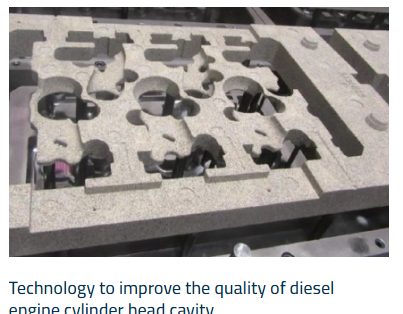Rapid Pattern Creation
Sand casting the traditional way involves creating an actual pattern, usually from wood or metal, which can take weeks to produce. On the other hand when we apply 3D printing for sand casting, it enables a direct and fast fabrication of these patterns from digital design. In some cases, this can turn a weeks-long pattern production process into a matter of days, if not hours, based on the complexity and scale of the pattern. Moreover, 3D printing can deliver ±0.5 mm precision patterns, improving the level of sand molds precision.
Complexity and Detail
Compared to traditional pattern making, 3D sand printing allows for more complex and detailed designs that are too challenging or impossible for pattern makers to produce. Internal features and undercuts have no problem being made with 3D printers, those features are simple constructions, without a need of multi core or multiple part molds. This capability enables designing with functional integration, while still having structural integrity.
Low-Volume Production Cost Efficiency
The expense of producing a new mold for each small-run and most prototype sand-castings used to be prohibitive. As a result the costs for creation of the pattern are significantly lower and thus sand casting with 3D printed patterns can also become economic in case of small batch sizes. There are, however, significant cost saving gains to be had in the reduced requirements for expensive tooling and in the re-use of digital models for future productions.

Increased Tailorability and Speed to Lead
With the speed at which patterns can be made via 3D printing, lead times are greatly reduced but even more importantly, it adds flexibility to the production planning process and quick response to shifts in market demand. In seconds, instead of weeks, manufacturers can adjust to changes in design by downloading the new digital files, and printing the nuevos shapes over the same pattern below that pattern on the fly to be able to practice agile manufacturing and respond to customer demand quickly.
Reduced Waste
For example, traditional pattern making would often involve a considerable amount of waste, particularly when using materials such as wood and metal. Each layer meant that less material was used to create the pattern); thus, 3D printing is a way to eliminate waste. Besides being cost-efficient, this material-efficient design is also eco-friendly as it contributes to sustainable manufacturing by minimizing the environmental footprint of the production process.
Back to the drawing board with simulation software
By employing 3D printing along advanced simulation software, a sand casting process can be virtually optimized well before the physical pattern is printed. Engineers can simulate the mold filling, cooling and solidification and then appropriately modify the design to enhance the cast part quality and integrity. The integration allows for better detection and troubleshooting of potential casting defects, such as air entrapment or incomplete filling to drive yield and quality of the finished products.
Improved Surface Finish and Dimensional Accuracy
The surface finish and dimensional accuracy of sand cast parts are very much affected by the quality of sand mold, which in turnonce again has an interdependence on the pattern quality. The patterns used to cast the mold are made by 3D printing, which are smoother and more accurate than the typical patterns made using traditional methods, so the surface finish and the overall dimensional accuracy of the final casting is improved. In other words, post-casting procedures such as machining and finishing can be done lesser following, which reduces the overall time and cost of production.
Finally, 3D printing adds an entirely new facility to the traditional sand casting process with faster pattern production, intricate design capabilities, low volume cost reduction, increased foundry flexibility, and casting sustainability. This combination of state of the art 3D print technology and traditional sand casting techniques is one that is breaking new ground in metal casting.
